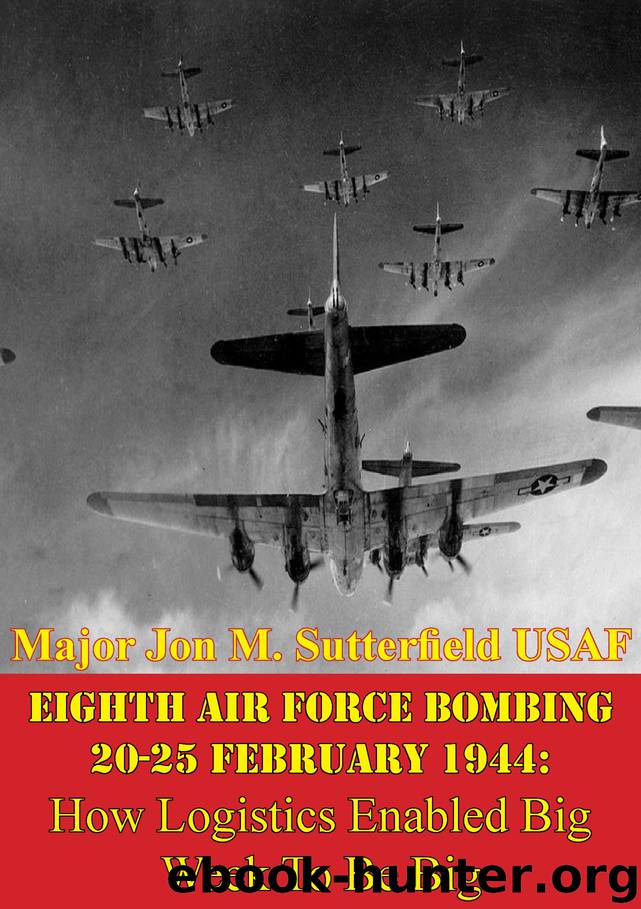Eighth Air Force Bombing 20-25 February 1944 by Major Jon M. Sutterfield USAF

Author:Major Jon M. Sutterfield USAF
Language: eng
Format: epub
Publisher: Pickle Partners Publishing
Published: 2015-10-13T16:00:00+00:00
Transportation
Knerr tried to address airlift problems, which he had foreseen, with distribution and control of airlifted supplies by trying to secure dedicated airlift he had apparently been promised. In the summer of 1943 he wrote, “Not more than 3 percent of the required airlift has ever been forthcoming in the United States from that promised service.”{113} With the exception of inter and intra-island air service 8AF was relieved of airlift functions and they were placed under the Air Transport Command sometime in the summer of 1943. Knerr later wrote in his lessons learned, dated 10 May 1945, that air cargo had been delivered to places where it was “extremely difficult to assemble and process” and that units and equipment were separated from each other delaying unit mission execution in the theater.{114} A military airline was formed by 8AF for moving troops and supplies throughout the UK and proved its merit by moving an average of 300 tons of cargo and 2,500 personnel per month in 1943.{115}
The ASF controlled what was shipped via sea to the UK. Knerr felt the ASF mismanaged sea shipments and although it never happened, he felt the Air Force should have been allocated dedicated sealift.{116}
Knerr addressed many key logistical problems in 1943. Not the least of his efforts included resisting the return of the Truck Transport Service to the SOS because “until the Air Forces took over segregation and distribution of their own supplies from shipside (sic) to consuming unit, they starved.”{117} In addition to inter-service squabbles over control of the ground transport function was the shortage of vehicles. “A truck shortage adversely affected distribution, although it was mitigated by Britain’s fine transportation system.”{118} In addition, 8AF trucks were pooled into a single organization and were effective and efficient in moving supplies from port to base and laterally between bases.{119}
The bottom line on transportation was that 8AF made the best of a bad situation. They operated an intra-theater airlift service but depended on Air Transport Command for inter-theater airlift. It appears that this combination of inter-theater and intra-theater support satisfied the airlift needs of 8AF despite its dependence on another command for the former. Despite the sealift problems Knerr felt the ASF created, he never was able to secure dedicated sealift so we will never really know if it would have improved 8AF logistical support during the month proceeding Big Week.
Download
This site does not store any files on its server. We only index and link to content provided by other sites. Please contact the content providers to delete copyright contents if any and email us, we'll remove relevant links or contents immediately.
| Africa | Americas |
| Arctic & Antarctica | Asia |
| Australia & Oceania | Europe |
| Middle East | Russia |
| United States | World |
| Ancient Civilizations | Military |
| Historical Study & Educational Resources |
Before Topgun Days: The Making of a Jet Fighter Instructor by Dave Baranek(793)
Enemy Coast Ahead by Guy Gibson(685)
The SAS Training Manual by Chris McNab;(673)
The True Story of Catch 22 by Patricia Chapman Meder(587)
Comet! The World’s First Jet Airliner by Graham Simons(581)
Outlaws Inc. by Matt Potter(564)
Airborne by Tom Clancy(527)
The Other Side of Airfix by Authur Ward(525)
The Wright Company by Edward J. Roach(522)
Memoirs of a Stuka Pilot by Helmut Mahlke(508)
Beyond Band of Brothers by Richard D. Winters(500)
Hitler's Eagles by Chris McNab(495)
Air Warriors by Douglas Waller(463)
Boyd by Robert Coram(459)
Stormchasers by David Toomey(451)
Pegasus, The Heart of the Harrier: The History and Development of the World's First Operational Vertical Take-off and Landing Jet Engine by Andrew Dow(448)
Airborne (1997) by Clancy Tom(445)
Focke-Wulf Fw 190 by CHRIS GOSS(424)
I Always Wanted to Fly by Wolfgang W. E. Samuel(409)
